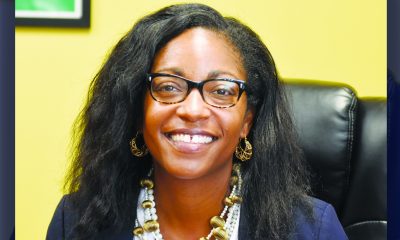#NNPA BlackPress
What it truly means to be a leader
DAYTONA TIMES — According to Webster’s Dictionary, the word leader is defined as one who commands a country, organization or group. Growing up, it was crucial to have positive role models and community leaders to keep us on track and to make our communities safer and more efficient. As the Executive Director of Community Healing Project Inc, I truly believe being a leader and a positive force in your community should be an obligation for every able-bodied citizen. As well as influencing the youth to gain knowledge, self-respect and self-worth.
According to Webster’s Dictionary, the word leader is defined as one who commands a country, organization or group. Growing up, it was crucial to have positive role models and community leaders to keep us on track and to make our communities safer and more efficient. As the Executive Director of Community Healing Project Inc, I truly believe being a leader and a positive force in your community should be an obligation for every able-bodied citizen. As well as influencing the youth to gain knowledge, self-respect and self-worth.
Being a leader is an enormous amount of pressure and it takes a person with dedication, compassion, empathy and a very forgiving heart to be great at it. After collaborating with some of the most influential activists and politicians around the nation, I’ve finally discovered the key and cracked the code of not only being a true boss but also being an influential and motivational leader.
Remember your roots
Understanding your community and the families who live there are the most important part of becoming the best leader you can be. In every city in America there is a low-income, urban and minority-focused set of apartments and complexes who truly struggle every single day. Take a second of your time to get to know and understand those that are suffering the most around you.
With poverty and illiteracy rates in urban communities resurfacing to an all-time high, its truly time to invest not only economically but spiritually and physically as well. Putting the love back into the community with programs, events, and cookouts promote positivity and unity and gives us a chance to discuss serious issues that plague our communities. No matter how far you make it, never forget your roots!
Never compromise
Staying grounded and humble will maximize your influence and the way others respect you. When it comes to fighting for a cause or movement you must know when to “hold em and when to fold em”. Sometimes it’s best to analyze a situation before instantly reacting and making things even worse. I’ve had the displeasure of dealing with this way too many times as I was so eager to make a difference.
I was so focused on getting results and seeing action, that I would act on my emotions instead of my logic. Once you get the hang of voicing your opinions in a respectable and impactful way, you’ll attain a level of balance and peace of mind that will only improve your skills as a leader and boss. Stay true to yourself and never compromise your morality for the benefits.
While the attention and success will always captivate you, you must always remember that not everyone will be a fan of what you do. And as history has shown, some of our greatest and most influential leaders were strangely taken before their time, due to mysterious circumstances.
By any means necessary
Being a social activist, you must understand that an open target is always on your head and sometimes it’s better to silence someone than to try and understand their truth. You should always prepare yourself mentally before you strive for greatness. Great leaders make sacrifices, and you must truly be ready to fight to keep your integrity, by any means necessary.
For centuries, we’ve been told our heroes wore capes and hide behind masks. These heroes are fearless, brave and would give their life to prove their integrity. From the radical efforts of Malcolm X, to the psychotic world of Charles Manson, we’ve always been able to identify powerful leaders in society, whether they had positive or negative influences on the culture. Ironically, these men not only dominated culture in the 1960s, but they influenced a whole new generation of followers who would emulate their footsteps.
No matter which side of history these leaders decided to stand on, they all had one very powerful trait in common. They were natural-born leaders, and they truly changed the world, one community at a time. Being a great leader takes patience, understanding, passion and a true heart for the greater good. The world needs more incredible, positive, intelligent leaders and it’s time to seize that moment more than ever before.
Rell Black is an award-winning activist, blogger and the founder of Community Healing Project Inc.
This article originally appeared in the Daytona Times.
#NNPA BlackPress
High Court Opens Door to Police Accountability
BLACKPRESSUSA NEWSWIRE — The U.S. Supreme Court unanimously rejected a judicial doctrine that for years shielded law enforcement officers from civil liability in police shooting cases by allowing courts to assess force based only on the final moments before an officer pulled the trigger.

By Stacy M. Brown
Black Press USA Senior National Correspondent
The U.S. Supreme Court unanimously rejected a judicial doctrine that for years shielded law enforcement officers from civil liability in police shooting cases by allowing courts to assess force based only on the final moments before an officer pulled the trigger. In Barnes v. Felix, the high court struck down the Fifth Circuit’s “moment-of-threat” rule, which had been used to justify the 2016 killing of Ashtian Barnes, a Black man shot during a traffic stop outside Houston. Officer Roberto Felix fired two shots into Barnes’s moving car after stepping onto the doorsill. The lower courts determined that only the two seconds before the shooting—when Felix was holding onto the vehicle—mattered in deciding whether the use of deadly force was reasonable. The Supreme Court disagreed. Writing for the unanimous Court, Justice Elena Kagan made clear that determining whether an officer’s use of force is reasonable under the Fourth Amendment requires an analysis of the totality of the circumstances, including all events leading up to the shooting. “A court deciding a use-of-force case cannot review the totality of the circumstances if it has put on chronological blinders,” the Court ruled.
The victim’s mother, Janice Barnes, brought the case under Section 1983, alleging that Felix violated her son’s constitutional rights. The ruling sends the case back to the lower courts for reconsideration under the broader standard set by the Supreme Court. According to the Constitutional Accountability Center (CAC), the Court’s ruling solidifies that police do not have special constitutional status and should be held to the same accountability standards. “The moment-of-threat rule is entirely unsupported by the Constitution’s text and history,” said Nargis Aslami, a fellow at CAC. Chief Counsel Brianne Gorod added, “The Court took a small but important step toward greater accountability for police officers who violate the Fourth Amendment by inflicting unnecessary violence during their encounters with the public.” The ruling comes as data continue to show disproportionate police encounters and violence against Black Americans. A NAACP Criminal Justice Fact Sheet revealed that a Black person is five times more likely than a white person to be stopped without just cause. Black men are twice as likely to be stopped as Black women. Meanwhile, 65% of Black adults say they have felt targeted because of their race.
Each year, between 900 and 1,100 people are shot and killed by police in the United States. Since 2005, at least 98 non-federal law enforcement officers have been arrested for fatal on-duty shootings. Still, only 35 have been convicted—and just three have been convicted of murder with the convictions upheld. Recent data from the Prison Policy Initiative show that while white residents are most likely to initiate contact with police—for reasons like reporting crimes or seeking help—Black, Hispanic, and Asian individuals are more likely to be on the receiving end of police-initiated contact, including street stops, traffic stops, and arrests. Traffic stops, which remain the most common form of police-initiated contact, are also among the most lethal. According to Mapping Police Violence, over 100 police killings occurred during traffic stops in 2023. The Bureau of Justice Statistics reports that 62% of Black people whose most recent police contact in 2022 was initiated by officers were drivers in traffic stops. That compares to 56% to 59% among other racial groups. Black drivers were searched or arrested at a rate of 9%—more than double that of white drivers and significantly higher than Hispanic or Asian drivers. “The Supreme Court’s decision in Barnes v. Felix is crucial not only for police accountability but also for broader constitutional protections,” the North Star Law Group wrote in a post. “If the Court upholds the ‘moment of threat’ standard, it could make it even harder to hold officers accountable for excessive force. However, if it reinforces the ‘totality of circumstances’ standard or adopts a hybrid approach, it could create a fairer system that protects both civilians and responsible police officers.”
#NNPA BlackPress
Workplace Inequity Worsens for Black Women
BLACKPRESSUSA NEWSWIRE — Meanwhile, they remain underrepresented in high-wage fields like tech, law, and executive management—even when they hold the degrees and credentials to qualify.

By Stacy M. Brown
Black Press USA Senior National Correspondent
Black women remain the backbone of the U.S. labor force—working more, earning less, and bearing greater burdens across nearly every sector. Even as the country added 177,000 jobs in April, Black women lost 106,000 positions, the steepest decline of any group. Their unemployment rate jumped to 6.1%, according to the U.S. Bureau of Labor Statistics. But the losses go far deeper than a single month of data. Research shows Black women are not only overrepresented in low-wage industries like care, cleaning, education, and food service—they are also consistently denied advancement and paid significantly less than white male peers, even with the same credentials. In its July 2024 report, the Institute for Women’s Policy Research (IWPR) found Black women working full-time, year-round earned just 69.1 cents for every dollar paid to white men. That figure drops to 49.6 cents in states like Louisiana. “Black women consistently have higher labor force participation rates than other demographics of women,” officials from the National Partnership for Women and Families wrote. Yet those higher participation rates have not translated into pay equity or job security.
The earnings gap grows wider with age. For example, Black women aged 56 to 65 working full-time, year-round, earn just 59.3 cents for every dollar paid to white men in the same age group. Those in leadership roles report disproportionately high dissatisfaction with pay and access to advancement, with 90% of women of color in management saying systemic barriers hinder workplace progress. Additionally, according to a 2022 Health Affairs report, more than one in five Black women in the labor force are in health care—more than any other group. However, nearly two-thirds of them work as licensed practical nurses or aides, and 40% are in long-term care. These roles are among the lowest-paid and highest-risk in the industry, often involving grueling schedules, poor benefits, and unsafe conditions. Beyond health care, the National Employment Law Project found that more than half of Black women work in jobs where they are overrepresented, such as childcare, janitorial work, and food preparation. Meanwhile, they remain underrepresented in high-wage fields like tech, law, and executive management—even when they hold the degrees and credentials to qualify.
In Boston, Charity Wallace, a 37-year-old biotech professional, and Chassity Coston, a 35-year-old middle school principal, both say they’re leaning heavily on community and mental health strategies to cope with workplace challenges. “It’s a constant fight of belonging and really having your girlfriends or your homegirls or my mom and my sister,” Wallace told NBC News. “I complain to them every day about something that’s going on at work. So having that circle of Black women that you can really vent to is important because, again, you cannot let things like this sit. We’ve been silenced for too long.” Limited opportunities for promotion and sponsorship compound the isolation many Black women feel in their workplaces. In 2024, writer Tiffani Lambie described the “invisible struggle for Black women” at work. “The concept of ‘Black Girl Magic’ contributes to the notion that Black women are superheroes,” she wrote. “Although the intent of this movement was to empower and celebrate the uniqueness of Black women, the perception has also put Black women at greater risk of anxiety and depression—conditions that are more chronic and intense in Black women than in others.”
She warned that workplace conditions—marked by fear, lack of support, and erasure—threaten to push more Black women out of leadership and career pipelines. “If left untouched, the number of Black women in leadership and beyond will continue to decline,” Lambie wrote. “It is incumbent on everyone to account for these experiences and create an equitable and safe environment for everyone to succeed.” The Urban Institute recently spoke with a Black woman who transitioned from part-time fast food work to a full-time data entry role after completing a graduate degree. The job offered her better pay, health insurance, and stability. “It gives you a sense of focus and determination,” she said. “Now, I can build my career path.”
#NNPA BlackPress
Black Women Decimated by Job Loss in Trump Economy
BLACKPRESSUSA NEWSWIRE — The number of employed Black women dropped from 10.325 million in March to 10.219 million in April. Their unemployment rate jumped from 5.1% to 6.1%, the largest month-to-month increase among all racial and gender groups.

By Stacy M. Brown
Black Press USA Senior National Correspondent
According to newly released data from the U.S. Bureau of Labor Statistics, black women experienced the steepest job loss of any demographic group in April, shedding 106,000 jobs. The April report shows a significant setback for Black women in the labor market, even as the U.S. economy added 177,000 jobs and the national unemployment rate held steady at 4.2%. The number of employed Black women dropped from 10.325 million in March to 10.219 million in April. Their unemployment rate jumped from 5.1% to 6.1%, the largest month-to-month increase among all racial and gender groups. Among other findings, the labor force participation rate for Black women edged to 61.2%, indicating a loss in employment and a possible decline in overall workforce engagement. The unemployment rate for white women remained unchanged at 3.3%. Hispanic women’s unemployment also held at 4.6%. Women in other groups generally do not face the dual barriers of racial and gender discrimination that Black women contend with, a factor in the jobless rate gap.
The overall Black unemployment rate rose to 6.3% in April, up from 6.2% in March, marking the third straight monthly increase and the highest rate since January. In contrast, Black men saw a gain in employment, dropping their jobless rate from 6.1% to 5.6%. Asian Americans had the lowest unemployment rate in April at 3.0%, while the rate for Hispanic Americans was 5.2% and 3.8% for white Americans. HBCU Money reported that the number of Black women employed is now at a five-month low, while the number of unemployed Black women is at a five-month high. Economist William Michael Cunningham, owner of Creative Investment Research, told BLACK ENTERPRISE that the number of unemployed Black Americans increased by 29,000 in April, reaching nearly 1.4 million. At the same time, the total Black labor force declined by 7,000. “The unusual nature of this increase in Black women’s unemployment is a testament to and a direct result of the anti-DEI and anti-Black focus of the new administration’s policies,” Cunningham said. “This is demonstrably damaging to the Black community, something we have not seen before.”
Cunningham noted that many Black women are searching for jobs but not finding them. He said eliminating diversity, equity, and inclusion roles and cuts in federal government jobs are key contributors. The BLS reported that federal government employment dropped by 9,000 in April and is down 26,000 since January. “For Black women, the numbers show that those seeking work are not finding jobs,” Cunningham said. “The jobs that have traditionally been a path to stability are disappearing.” Nationwide, job growth continued in health care, transportation and warehousing, financial activities, and social assistance. Average hourly earnings increased by six cents to $36.06. The Employment Situation for May is scheduled for release on Friday, June 6.
-

 Activism3 weeks ago
Activism3 weeks agoAI Is Reshaping Black Healthcare: Promise, Peril, and the Push for Improved Results in California
-

 Activism4 weeks ago
Activism4 weeks agoOakland Post: Week of April 16 – 22, 2025
-

 Activism3 weeks ago
Activism3 weeks agoNewsom Fights Back as AmeriCorps Shutdown Threatens Vital Services in Black Communities
-

 Activism3 weeks ago
Activism3 weeks agoBarbara Lee Accepts Victory With “Responsibility, Humility and Love”
-

 Activism3 weeks ago
Activism3 weeks agoESSAY: Technology and Medicine, a Primary Care Point of View
-

 Activism3 weeks ago
Activism3 weeks agoFaces Around the Bay: Author Karen Lewis Took the ‘Detour to Straight Street’
-

 Activism3 weeks ago
Activism3 weeks agoTeachers’ Union Thanks Supt. Johnson-Trammell for Service to Schools and Community
-

 Alameda County3 weeks ago
Alameda County3 weeks agoOUSD Supt. Chief Kyla Johnson-Trammell to Step Down on July 1














































